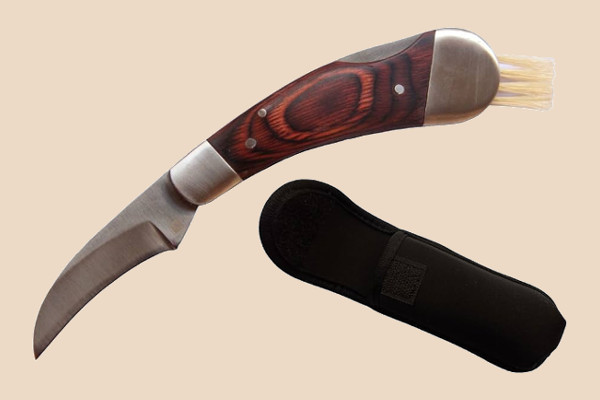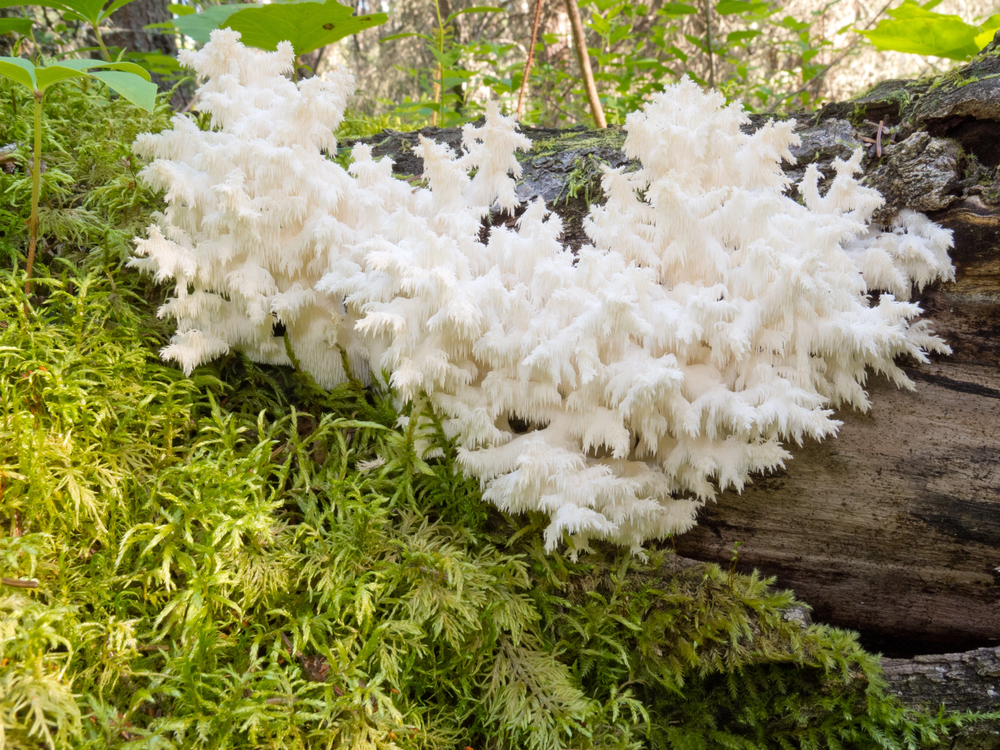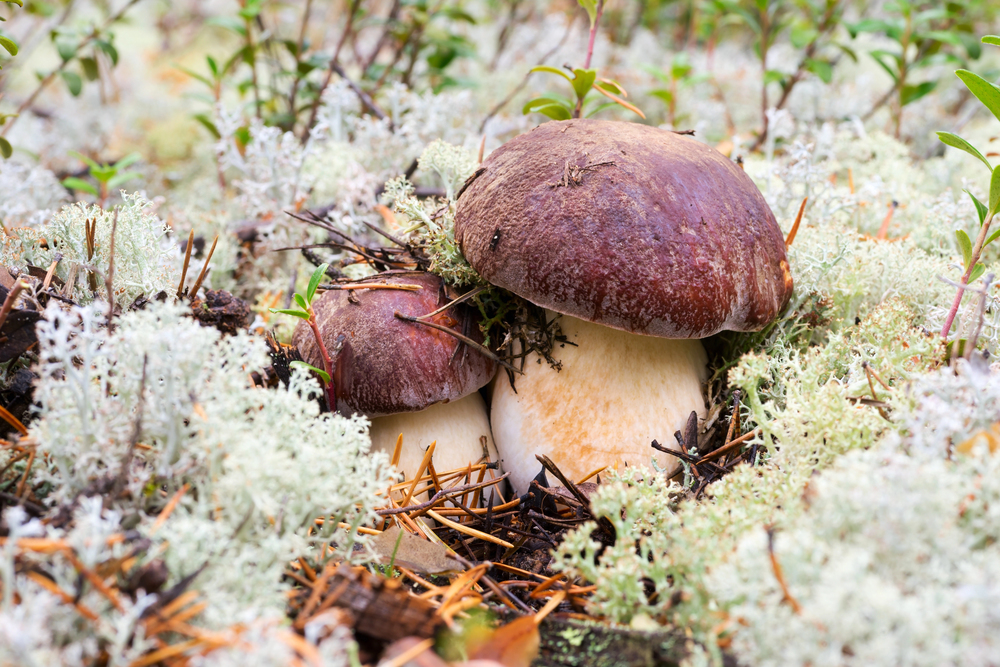As a gardener relies on a trowel, a mushroom hunter’s blade is essential for successful foraging. The type of knife you carry can make all the difference in your harvest as you navigate the forest in search of elusive mushrooms.
Each aspect of the knife, from specialized blade shapes to ergonomic handle materials, plays a crucial role in enhancing your mushroom hunting experience.
Ready to elevate your foraging game with the perfect tool in hand?
Blade of the Knife
Blade Shapes
In the selection of a mushroom foraging knife, it is important to take into account the various blade shapes that are available.
The blade shape plays a critical role in efficient mushroom harvesting in the wilderness. With a curved blade, you can cleanly cut mushroom stems without causing harm to the surrounding environment, enabling precise cuts and minimizing the risk of damaging nearby mushrooms.
If you are dealing with tougher mushrooms and dense vegetation, a tanto blade, renowned for its strength and durability, is the perfect choice. Its straight edge and reinforced tip make it excellent for slicing through thick stems and roots.
For a versatile option, a drop-point blade is worth considering. It is suitable for both delicate mushroom picking and more robust cutting requirements.
Blade Materials and Durability
Selecting the right blade material is essential for the longevity of your mushroom knife. Here are key points to keep in mind for blade durability:
- High Carbon Steel: Offers excellent edge retention and is easy to sharpen.
- Stainless Steel: Provides good corrosion resistance and requires low maintenance.
- Titanium Coated Blades: Combines steel strength with added durability and wear resistance.
Considering these options will help you choose a blade material that meets your needs and ensures your mushroom knife remains a reliable tool for your foraging adventures.
Rust Resistance
For long-lasting durability and minimal upkeep, opt for a mushroom knife with excellent rust resistance.
Stainless steel or high-carbon steel blades are ideal choices as they’re less likely to rust when exposed to moisture during your foraging trips.
Stainless steel is particularly known for its corrosion resistance, requiring little maintenance and allowing you to focus on your mushroom hunting.
High-carbon steel, although very sharp, may need more care to prevent rust but is a sturdy option for outdoor use.
Choosing a mushroom knife with superior rust resistance ensures that your tool remains dependable and always ready for your needs.
Sharpness Retention
Opt for a mushroom knife with a blade crafted from high-quality steel to ensure long-lasting sharpness. Consider blades made of high carbon steel for exceptional sharpness and easy sharpening, stainless steel for corrosion resistance, or Damascus steel for beautiful patterns and superb edge retention.
Choosing the right blade material will keep your knife sharp for all your foraging needs.
Folding vs Fixed Blades
Deciding between a folding and fixed blade for mushroom foraging knives can greatly impact your experience. Here’s a comparison to help you choose:
| Aspect | Folding Blade | Fixed Blade |
|---|---|---|
| Portability | Compact and fits in your pocket or backpack easily | Larger and may need a sheath for carrying |
| Strength | Hinge may break under pressure | Sturdier and reliable for heavy-duty tasks |
| Maintenance | Requires occasional cleaning and oiling for the hinge | Easier to clean due to lack of moving parts |
Consider your foraging needs and preferences to make the best choice.
Safety Features
Safety is paramount when choosing a mushroom foraging knife.
To ensure a safe experience, look for a knife with:
- A secure locking mechanism
- A finger guard for protection
- A non-slip handle for a firm grip
- A blade cover for safe storage and transportation.
Handle Materials
When selecting a mushroom foraging knife, it is beneficial to weigh the advantages of different handle materials, such as wooden handles known for their comfortable grip and traditional aesthetics.
On the other hand, synthetic handles provide superior durability and moisture resistance, making them a practical option for prolonged usage in diverse weather conditions.
Understanding the distinctions between these handle materials can assist you in selecting a knife that aligns with your foraging needs and preferences.
Wooden Handle Benefits
Wooden handles provide a traditional and ergonomic grip for mushroom foraging knives, offering a comfortable feel in your hand. The natural warmth and texture of wood make it easier to hold for extended periods while searching for mushrooms.
Wooden handles mold to your grip over time, enhancing the overall user experience. As a renewable resource, wood appeals to those prioritizing sustainability.
The aesthetic appeal of wooden handles adds charm to your foraging gear, connecting you to nature as you hunt for mushrooms. Overall, wooden handles combine practicality, comfort, and eco-friendliness, making them a popular choice among mushroom foragers.

Synthetic Handle Durability
For optimal durability, synthetic handles provide a lasting and dependable choice for mushroom foraging knives. A synthetic handle is designed to withstand outdoor conditions and heavy use, offering the following benefits:
- Weather Resistance: Resistant to warping or cracking in damp conditions.
- Easy Maintenance: Simple wipe-down to keep the handle looking new.
- Comfortable Grip: Ergonomic design for a secure and comfortable hold.
- Longevity: Built to last for numerous mushroom hunting expeditions.
Handle Ergonomics
Considering the comfort and functionality of the handle is crucial when picking a mushroom knife. The handle is your connection to the blade, so it needs to feel comfortable in your grip. Look for a knife with an ergonomic handle that fits well in your hand, allowing you to maintain a secure hold while foraging for mushrooms. A handle that’s too small or too large can cause discomfort and fatigue, hindering your mushroom hunting experience. Opt for a handle made from materials like wood, rubber, or plastic that offer a good grip even when your hands are wet or slippery.
Ensure the knife’s handle has a design that prevents it from slipping during use. Some handles come with textured surfaces or finger grooves that enhance your grip and reduce the risk of accidents. Consider the overall balance of the knife in your hand – a well-balanced handle will make your cutting tasks easier and more efficient. By prioritizing handle ergonomics, you’ll be equipped with a mushroom knife that not only performs well but also feels comfortable to use for extended periods.
Size and Weight of the Foraging Knife
To find the right mushroom knife, prioritize a balance between size and weight. Consider the following:
- Compact Size: Choose a knife that fits comfortably in your pocket or backpack for easy carrying.
- Lightweight: Opt for a sturdy yet lightweight knife to avoid fatigue during long mushroom foraging trips.
- Balanced Feel: Look for a knife that feels balanced in your hand for easy maneuvering and precise cuts without straining your wrist.
Multi-tool Options
For mushroom foraging knives, there are various versatile multi-tool options available that cater to different needs.
These knives are compact and practical, offering multiple functions in one tool, such as saws, brushes, and various blade options to enhance the foraging experience.
Versatile Knife Options
For a practical and efficient mushroom foraging experience, having a versatile knife with multi-tool options can greatly enhance your foraging toolkit. Look for these features to maximize your freedom in the wilderness:
- Interchangeable Blades: Switch between a sharp blade for cutting mushrooms and a serrated blade for tougher tasks.
- Built-in Compass: Navigate through the forest with ease using a reliable compass.
- Detachable LED Light: Illuminate dimly lit areas for dusk or dawn foraging adventures.
- Firestarter: Start a fire for warmth or cooking while out in the wild.
Compact and Practical
For a compact and practical mushroom foraging experience, opt for a multi-tool that offers versatility and convenience in the wild. Look for a tool that includes a sharp knife for cutting mushrooms, a brush for cleaning, a small saw for thicker stems, and maybe even tweezers for delicate handling.
These compact tools can easily fit in your pocket or backpack, making them ideal for extended foraging trips. With a sturdy yet lightweight multi-tool, you’ll have everything you need for a successful mushroom hunting adventure.
Features for Foragers
Explore the range of multi-tool options to enhance your mushroom foraging experience with convenience and efficiency.
- Versatility: Enjoy the freedom of multiple tools in one compact device for effortless task handling.
- Portability: Carry a lightweight tool for easy transportation during your foraging trips.
- Durability: Rely on a sturdy multi-tool built to withstand outdoor exploration for long-lasting use.
- Functionality: Access a variety of functions at your fingertips for a seamless foraging experience.



